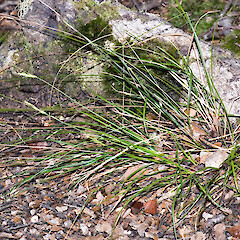Carex minor
Common name
bastard grass, hook sedge
Synonyms
Uncinia angustifolia Hamlin; Uncinia rupestris Raoul var. planifolia Kük.
Family
Cyperaceae
Flora category
Vascular – Native
Endemic taxon
Yes
Endemic genus
No
Endemic family
No
Structural class
Sedges
NVS code
The National Vegetation Survey (NVS) Databank is a physical archive and electronic databank containing records of over 94,000 vegetation survey plots - including data from over 19,000 permanent plots. NVS maintains a standard set of species code abbreviations that correspond to standard scientific plant names from the Ngä Tipu o Aotearoa - New Zealand Plants database.
UNCANG
Chromosome number
2n = 88
Current conservation status
The conservation status of all known New Zealand vascular plant taxa at the rank of species and below were reassessed in 2017 using the New Zealand Threat Classification System (NZTCS) – more information about this can be found on the NZTCS website. This report includes a statistical summary and brief notes on changes since 2012 and replaces all previous NZTCS lists for vascular plants.
Please note, threat classifications are often suggested by authors when publications fall between NZTCS assessment periods – an interim threat classification status has not been assessed by the NZTCS panel.
- Conservation status of New Zealand indigenous vascular plants, 2017 . 2018. Peter J. de Lange, Jeremy R. Rolfe, John W. Barkla, Shannel P. Courtney, Paul D. Champion, Leon R. Perrie, Sarah M. Beadel, Kerry A. Ford, Ilse Breitwieser, Ines Schönberger, Rowan Hindmarsh-Walls, Peter B. Heenan and Kate Ladley. Department of Conservation. Source: NZTCS and licensed by DOC for reuse under the Creative Commons Attribution 4.0 International licence.
2017 | Not Threatened
Previous conservation statuses
2012 | Not Threatened
2009 | Not Threatened
2004 | Not Threatened
Distribution
Endemic. New Zealand. North, South and Stewart Islands. In the North Island from Central Volcanic Plateau south (common around Wellington), on the other islands rather locally distributed and often absent.
Habitat
Coastal to upper montane. In forest, along forest margins and in scrub.
Detailed description
Dark green, loosely tufted plants. Culms few, 100–350 × c. 0.3 mm, glabrous, 1–2 mm diameter at base (including sheathing bracts); basal bracts light to dark brown, not shining. Leaves 3–4 per culm, < culms, from slightly > 0.5 mm to 1.5 mm wide, dark green, strongly scabrid on margins and upper surface. Spike 20–50 × 2–3 mm, occasionally bracteate, female flowers 5–12, internodes up to 4 mm long at base of spike, 1.5–2.0 mm long above. Glumes usually c. ½ length of utricles, deciduous, ovate, acute or acuminate, hyaline with green midrib. Utricles 3.5–5.0 × c. 1 mm, trigonous, green to grey-brown, lateral nerves strongly developed, otherwise smooth, occasionally spreading when mature, beak 1.0–1.5 mm long, stipe c. 1 mm long.
Similar taxa
Very similar to Carex horizontalis (Colenso) K.A.Ford from which it chiefly distinguished by its much smaller overall stature, although the line of demarcation is not rigid and intergrades occur. While elsewhere this species is sympatric with C. horizontalis it would appear that it is the only species present in the immediate Wellington area. From Carex horizontalis, C. minor is further distinguished by its very early flowering time (September–October cf. October–November in C. horizontalis)
Flowering
September–October
Fruiting
November–December
Propagation technique
Easily grown from fresh seed and by division of established plants - though these may take a while to settle. Prefers a permanently damp, shaded site in a deep rich soil.
Etymology
carex: Latin name for a species of sedge, now applied to the whole group.
minor: Smaller
Where To Buy
Not Commercially Available
Attribution
Fact sheet prepared for NZPCN by Peter J. de Lange 17 August 2006. Description adapted from Moore and Edgar (1970).
References and further reading
Moore LB, Edgar E. 1970. Flora of New Zealand, Volume II. Indigenous Tracheophyta: Monocotyledones except Gramineae. Government Printer, Wellington, NZ. 354 p.
NZPCN Fact Sheet citation
Please cite as: de Lange, P.J. (Year at time of access): Carex minor Fact Sheet (content continuously updated). New Zealand Plant Conservation Network. https://www.nzpcn.org.nz/flora/species/carex-minor/ (Date website was queried)







